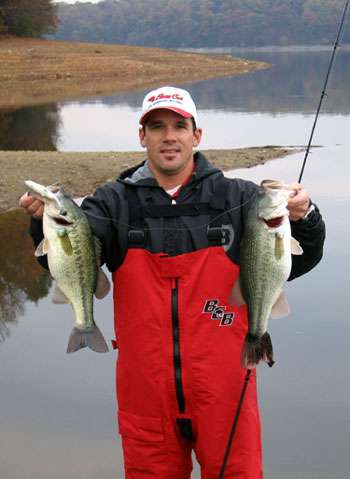
Sometimes the best way to trick-out a bait is to fish it in an unusual way — do something different with it. After all, the idea is to give the bass something they haven't seen before. Elite Series angler Grant Goldbeck does just that with soft plastic swimbaits.
"I don't dispute that you can catch a lot of cold water bass with jigs and other traditional lures," he says. "But I wanted to try something different. During this off-season I started experimenting with plastic swimbaits. They catch fish in the spring, summer and fall, why wouldn't they work in the wintertime?"
He first started fishing them in cold water in the traditional manner — letting the bait sink and then slowly reeling it back to the boat. But he soon found that his bite was better if he maintained constant contact with the bottom.
Over time he refined his cold water — around 52 degrees — largemouth technique by stopping the swimbait from time to time. "Forward weighting of the lure seems to work best. And, using a 6-inch ABT soft series Wagtail helped, too. It's important that the lure stays upright with the dorsal fin on top. The Wagtail does that."
Maintaining constant bottom contact with these lures isn't easy, however. (They aren't called swimbaits for nothing.) And so, Goldbeck discovered another refinement that he believes makes the difference between a good day of fishing and a great day of fishing — working the lure uphill rather than downhill.
"I think that's the key to the whole thing, really. It'll let you maintain contact with the bottom on the drag and also when you stop. You don't waste so much time letting the lure fall."
Goldbeck's tackle and tips
1. Use a heavy baitcasting combo spooled with 20-pound-test Sunline Sniper FC fluorocarbon line. This will give you the power you'll need at deeper depths.
2. Use a plastic swimbait that's forward weighted and that won't roll over when you stop it. Goldbeck recommends an ABT 6-inch Wagtail.
3. This technique is most productive in cold water with the bait moving uphill, along offshore humps and other forms of permanent structure.
4. Watch your line. A high percentage of your best strikes will come when the bait is holding still, sitting motionless on the bottom
"I'm just getting started with this. There'll be refinements that I've not thought about that other guys will, and it'll get even better as time goes along. The important thing is for us, as anglers, to think outside the box when it comes to catching bass."




